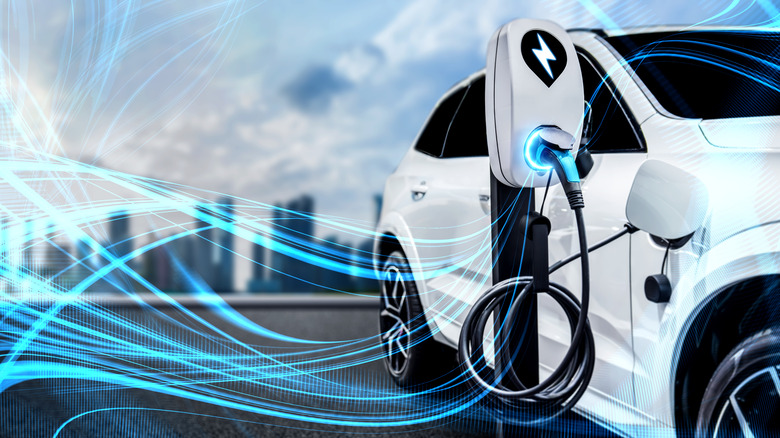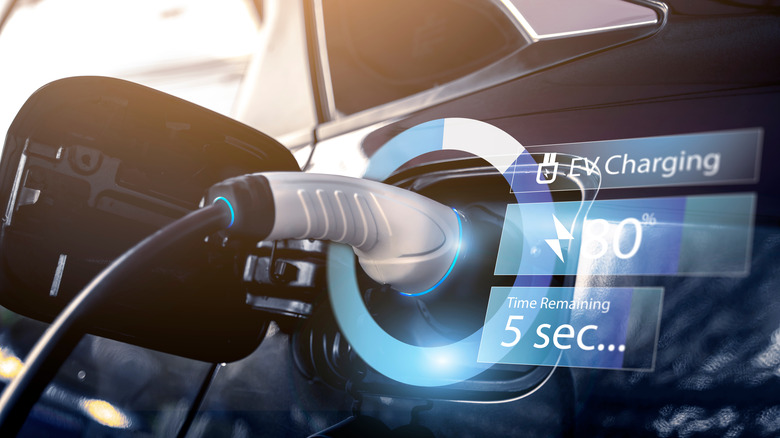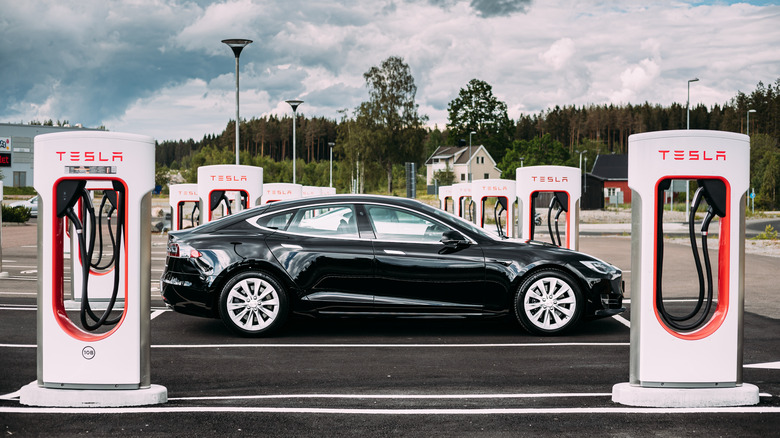The Big Electric Car Charging Problem Experts Say Is Getting Worse
Electric cars are, in no uncertain terms, the way of the future. Electric vehicles have been dreamt about for almost 200 years, with the first prototype coming about in 1832, according to the Energy Saving Trust. Since then, though, the combustion engine has taken the world by storm and revolutionized the way people and goods move around the planet, but electric cars are now making a resurgence in the marketplace.
These days, electric vehicles can withstand the same kinds of physical demands that a gasoline or diesel powered car was once required for. Electric vehicles are traveling farther and performing better than ever before and, with states like California introducing legislation to ban sales of new gasoline powered vehicles by 2035, there's going to be an undeniable shift in the way people commute and travel more broadly in the very near future.
These dramatic changes are good for the environment, but they bring with them the potential for a new type of problem that must be accounted for and solved. Specifically, a surge in electric vehicles taking to the roads means a drastic uptick in charging demands and overall electricity use across the consumer and corporate marketplaces alike. Handling this additional charging burden will be crucial to facilitating a relatively seamless transition from combustion engine to electric powered vehicle as the standard mode of transportation.
Charger availability will make adoption either painful or painless
It will be crucial to build and maintain significant charging infrastructure throughout the country, in order to facilitate a shift toward electric-dominated U.S. road transportation. Without critical charging infrastructure in place, renters may find themselves essentially squeezed out of the marketplace for personal transportation vehicles. Excluding a growing segment of people living in the United States from the capacity of ownership in this regard would almost certainly result in the closing off of marketplace opportunities and economic mobility for an enormous contingent of American adults: 65% of households younger than 35 currently rent, according to the Pew Research Center.
Alternatively, additional legislation could be formulated to entice landlords to include charging equipment in homes and apartments that renters can't effectively or legally alter on their own. Independent of household modernizations, efforts to introduce vast charging resources for densely populated communities and renters is progressing in California and elsewhere.
Another important feature in charging infrastructure revolves around speed. The ability to charge an electric car quickly will be essential to keep traffic flowing and avoid discouraging potential EV owners. Currently, most drivers must stop at a gas station, and while the time to fill a gas tank can vary widely, AudiWorld users report an average wait of roughly 3 to 4 minutes. Comparatively, Pod Point notes, you can add a range of about 100 miles to an EV in roughly 35 minutes with a rapid charger.
Daytime charging must dominate the EV marketplace
In addition to the stressors that will need to be accounted for when re-imagining the national automotive marketplace, Stanford University has conducted significant research into grid usage and suggests that daytime charging must become the standard. Currently, electric vehicle drivers typically install charging equipment at home and plug in their vehicle at night to prepare for daily commutes to work and other chores. Stanford notes that once EV ownership arrives at mass adoption, however, nighttime charging alone could increase peak electricity usage by as much as 25%.
That's problematic for two reasons. First, charging that number of EVs at night could put more demand on the grid than clean energy installations like solar panels can provide. Though solar is growing in prevalence across homes in California and elsewhere, surging night charging demands might force gas power stations back online. Secondly, this spike in demand on a nightly basis will place additional stress on the grid itself, potentially leading to substantial power outages and infrastructure failures akin to the one that froze Texas in 2021 (via Science Direct).
This means that individual drivers, local businesses — as both service providers and employers — and relevant authorities will need to work as a cohesive unit to establish a new normal moving forward. While electric vehicles will play a key role in decarbonizing transportation, reaping the benefits from that will be more complicated than coaxing drivers out of their gas cars and trucks, regardless of how much is offered in EV tax credits and incentives.


